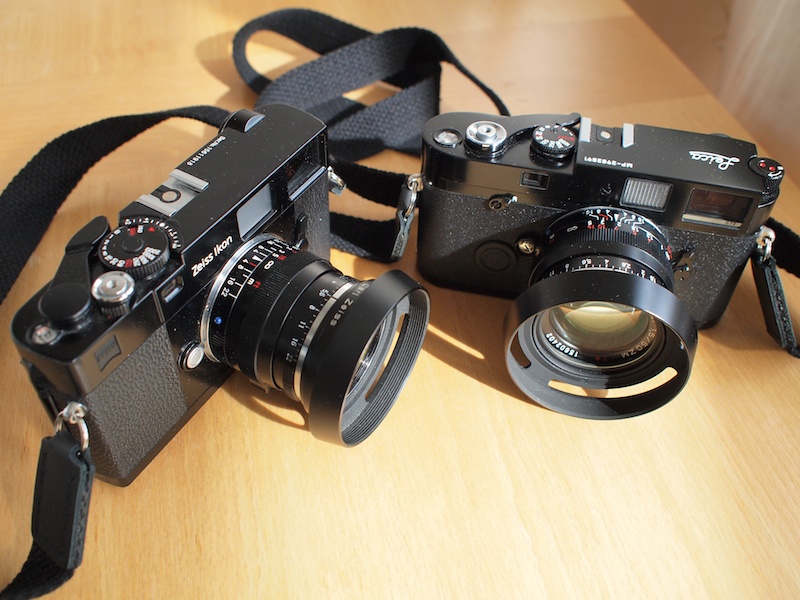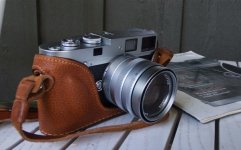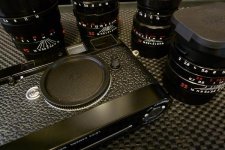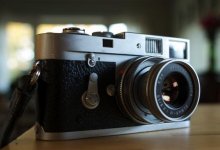You are using an out of date browser. It may not display this or other websites correctly.
You should upgrade or use an alternative browser.
You should upgrade or use an alternative browser.
Let's see your Leica M
- Thread starter colyn
- Start date
- Latest activity Latest activity:
- Replies 8K
- Views 4M
menos
Veteran
Beautiful! Looks brand new!
Everything working - frame previews clicky, slow speeds sound reasonable, shutter curtains close properly and don'r drag?
Everything working - frame previews clicky, slow speeds sound reasonable, shutter curtains close properly and don'r drag?
Darkhorse
pointed and shot
Beautiful! Looks brand new!
Everything working - frame previews clicky, slow speeds sound reasonable, shutter curtains close properly and don'r drag?
Everything seems A-OK so far. There's some slight signs of use, particularly at the bottom of the base plate where there's some scuffs.
The seller told me the leather on it is recent, even.
Checking the serial # this was made in 1980 in Ontario, Canada... just like me!
jarski
Veteran
menos
Veteran
Everything seems A-OK so far. There's some slight signs of use, particularly at the bottom of the base plate where there's some scuffs.
The seller told me the leather on it is recent, even.
Checking the serial # this was made in 1980 in Ontario, Canada... just like me!
Sounds like one to keep then ;-)
I've seen your classified - if I still had interest in adding Olympus, I'd jump on it.
I hope, you find a happy new owner - don't go to sell it in the shops - they won't be nice to you.
Harry Lime
Practitioner
Curious, why a TTL instead of classic?😕
I have a TTL and the flash support is incredibly useful for those rare occasions that I do use flash...
Harry Lime
Practitioner
Please be aware, that the TTL in the M6TTL only and exclusively means, that this adds TTL flash capability to the M6TTL.
The M6TTL anyway is very limited in all things flash (basically the same to your III).
The IIIF does not meter in any shape or form. There are no electronics in the camera and from what I remember the only thing they have in common is the sync speed of 1/50th.
The TTL and the M7 are the only analog M bodies that support TTL flash metering.
The M6TTL also adds a slightly bigger body size
The TTL top plate is 2mm taller. Other than that the bodies are identical in size and shape.
and a shutter speed dial, that turns "the wrong way".
Actually it's the right way, because it turns in the direction indicated by the meter display in the viewfinder.
It turns in the opposite way of the older meterless cameras like the M3/M2/M4 etc. I shoot a mix of M2/M4/M6ttl/M7 bodies and it's not really a big deal in practice.
It is reported, that it's meter also eats batteries faster than the M6 (and it's successor, the new MP).
A myth. I probably get close to 100 rolls from the batteries in my M6ttl. Maybe more.
I would save the money and go straight to the M6 classic.
If you get very lucky, you might source one, which has been upgraded to the MP finder specs, which should then price around a very good M6TTL, but have a superior finder.
Whichever camera you end up with I would get the upgrade. I had it to done to my TTL and M7 and it's well worth the money. I think DAG and some other shops are doing it for about $150-250.
This would be a much, much more helpful feature, than being able, to shoot with the handful of Leica TTL capable flash units.
Any flash, fitting the M6 hot shoe contacts will work in A and M mode anyway ;-)
The great thing about TTL flash support is that you don't spend your time screwing around with charts etc, trying to figure out what your settings are supposed to be.
You set the shutter to 1/50th and dial in your compensation on the flash (- 1 2/3 stop for me) and then bang away at whatever stop you want.
In very dark situations I sometimes like to shoot at 1.4 and set the compensation as low as -2 stops. I use a simple directional diffuser and bounce it off a wall or the ceiling.
This raises the ambient light level just enough to prevent all but the blackest of blacks from losing all detail and helps freeze motion a touch.
With practice the results do not look like they were taken with a flash and you can work very fast in moving situations. Without TTL metering this would not be possible, unless you had time to stop, meter and dial everything in by hand.
Personally I think it's a shame that Leica dropped TTL metering from the MP.
That was a step backwards.
Termik
Member
I've also got some cams! (One not being a Leica though)


Last edited:
cwcheung
Newbie
kshapero
South Florida Man
and a very good reason.I have a TTL and the flash support is incredibly useful for those rare occasions that I do use flash...
chrishayton
Well-known
my film M, MP Classic
I didnt actually know they made a Black paint 90mm Cron. Did it come with a kit? The rest is great too, MP Classic is one of my most desired leicas (after an M6J)
cwcheung
Newbie
I didnt actually know they made a Black paint 90mm Cron. Did it come with a kit? The rest is great too, MP Classic is one of my most desired leicas (after an M6J)
Not from the kit, it lanuched at 2003 when the MP 2003 lanuched. Total 500 pieces according to some Japanese Leica Magazines.
Last edited:
Pirate
Guitar playing Fotografer
My M2 is for 400 ISO B&W film. My M3 is for 25 ISO B&W film. 😀
Out to Lunch
Veteran
maggieo
More Deadly
squirrel$$$bandit
Veteran
a la carte m7 with the nokton 1.1/50
HELL of a nice M7, wow
menos
Veteran
a la carte m7 with the nokton 1.1/50
This one is extremely beautiful!
Pirate
Guitar playing Fotografer
The latest incarnation of mine:
1955 M3 DS w/Zeiss C Sonnar 50/F1.5 and 25 ISO film
1968 M2 w/Canon 50/F1.4 and 400 ISO film

1955 M3 DS w/Zeiss C Sonnar 50/F1.5 and 25 ISO film
1968 M2 w/Canon 50/F1.4 and 400 ISO film

thetooth
Well-known
Pirate
Guitar playing Fotografer
I really felt that my latest picture was just cheesy. I can't seem to take a nice picture of my cameras, so, I tried again.






Similar threads
- Replies
- 75
- Views
- 4K
- Replies
- 16
- Views
- 2K
- Replies
- 2
- Views
- 299
- Replies
- 3
- Views
- 587






